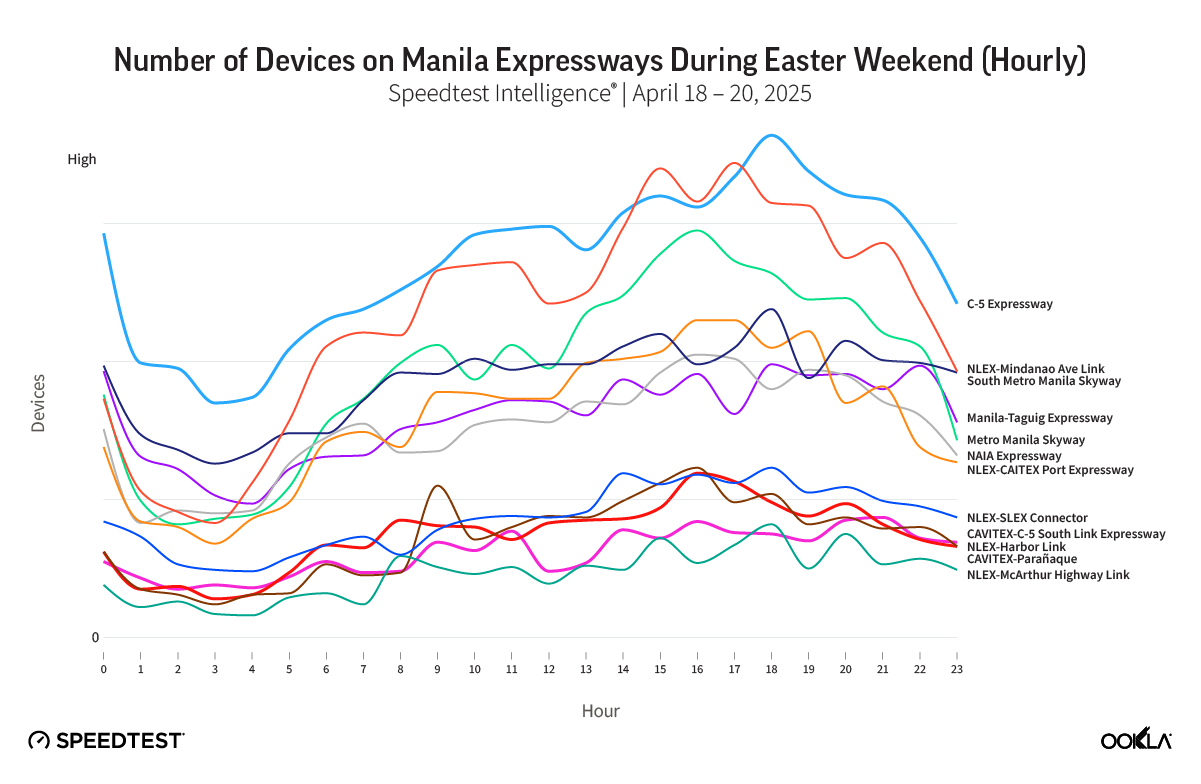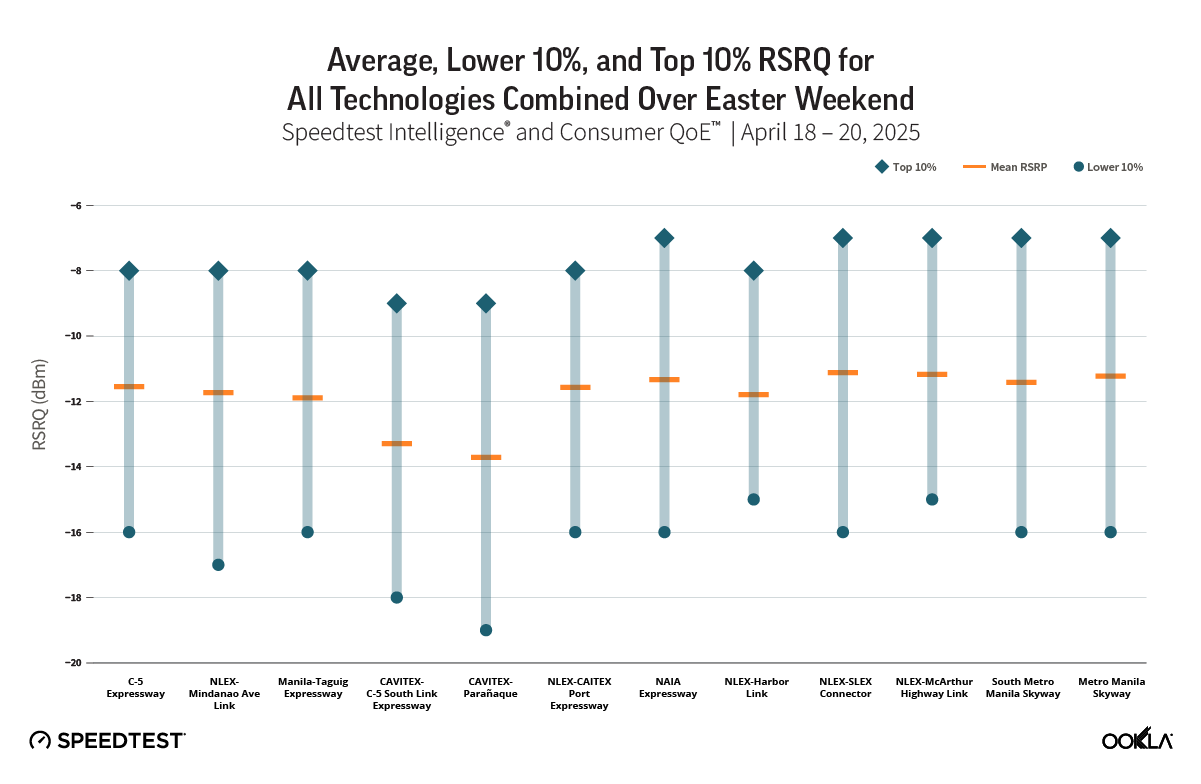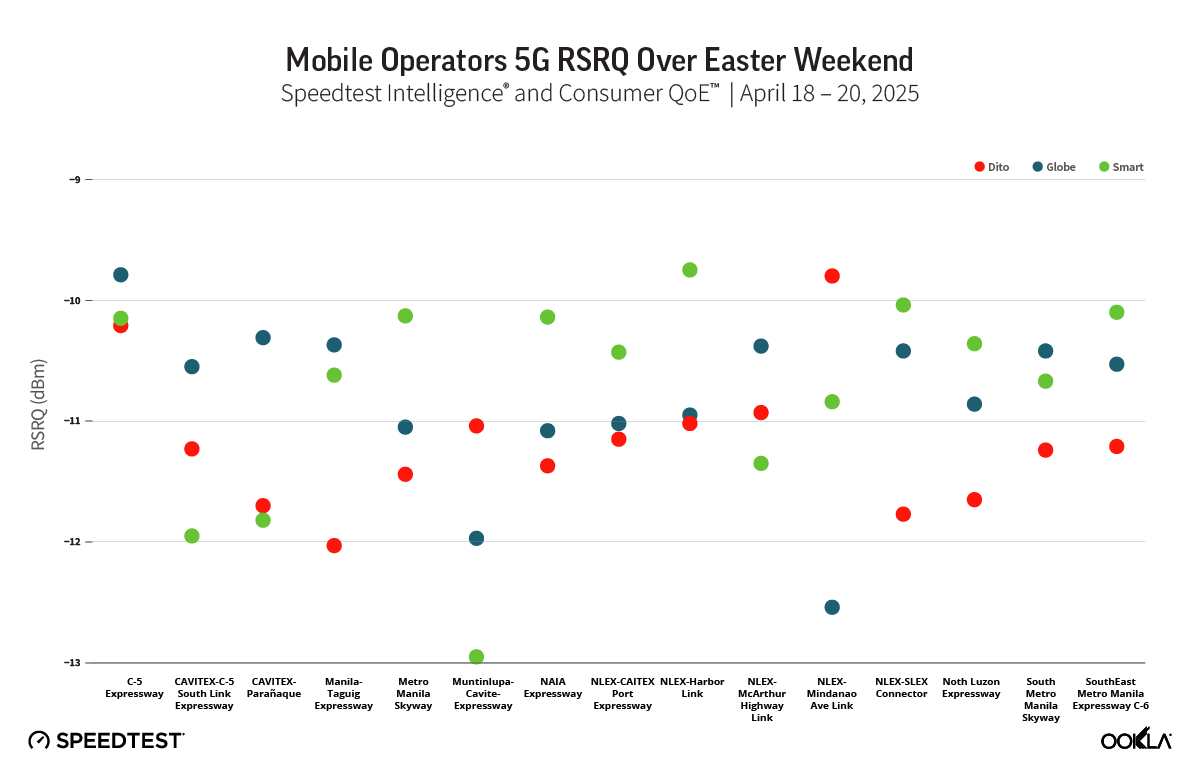
Easter Holiday Commute Highlights Progress and Gaps in Metro Manila Expressway Connectivity
Metro Manila continues to face severe traffic congestion, ranking first globally in the 2023 TomTom Traffic Index with an average travel time of 25 minutes and 30 seconds per 10 kilometers. Although it dropped to 15th in 2024, Manila remains one of the most congested capital cities in Southeast Asia. To ease mobility challenges, authorities have expanded the expressway network across and around the metro area. As these road corridors grow in importance, reliable mobile connectivity has become essential for navigation, communication, and access to digital services while on the move. This report examines mobile network performance along major expressways during the peak Easter holiday weekend to assess how well current infrastructure supports user demand in real-world conditions.
Key Takeaways
- Mobile coverage across Metro Manila’s expressways was generally strong, with most routes recording average RSRP better than -90 dBm. Metro Manila Skyway led in both signal strength (-84.67 dBm) and quality (-11.12 dB RSRQ), showing consistent performance. However, CAVITEX-Parañaque stood out for weaker coverage, with an average RSRP of -98.92 dBm and the lowest 10th percentile at -113 dBm.
- Most Metro Manila expressways provided widespread 5G coverage, with users spending more than 70% of their travel time on 5G across most routes. NLEX-McArthur Highway Link led with 87% 5G time, while service gaps were rare except in CAVITEX-Parañaque.
Linking Mobility and Connectivity on Metro Manila Expressways
The growing reliance on expressways for daily travel across Manila and its surrounding areas highlights the critical need for strong mobile connectivity along these major corridors. Reliable mobile access supports navigation, communication, ride-hailing, and emergency services. Coverage gaps or network interruptions can disrupt travel experiences and impact road efficiency. To address this, the Department of Public Works and Highways (DPWH), under its High Standard Highway Network Development Plan, has introduced policies to accelerate the deployment of telecommunications infrastructure along expressways.
Using Ookla’s coverage scans data across all mobile network operators, we analyzed mobile performance and quality of experience along 12 key expressways across Metro Manila during the Easter holiday (April 18th to 20th) weekend. The selected expressways include:
- C-5 Expressway
- CAVITEX-C-5 South Link Expressway
- CAVITEX-Parañaque
- Manila-Taguig Expressway
- Metro Manila Skyway
- NAIA Expressway
- NLEX-CAITEX Port Expressway
- NLEX-Harbor Link
- NLEX-McArthur Highway Link
- NLEX-Mindanao Ave Link
- NLEX-SLEX Connector
- South Metro Manila Skyway
These expressways form the core of Metro Manila’s road network, connecting major residential, commercial, and industrial areas. They link key cities such as Quezon City, Manila, Taguig, Parañaque, Pasay, and Makati, while extending to neighboring provinces like Bulacan and Cavite. They serve high volumes of daily commuters and provide critical access to airports, seaports, business districts, and suburban developments.
Easter Traffic Patterns Highlight Peak Mobile Usage on Southern Expressways
Using data from Speedtest® background samples, we combined hourly sample counts from all mobile operators over the three days to smooth out irregularities and highlight consistent usage patterns. The chart shows the total number of Speedtest samples collected per hour across 12 major Metro Manila expressways during April 18 to 20, 2025 (Easter weekend).
Data reveals a clear daily pattern: sample volumes were lowest between 00:00 and 05:00, began rising mid-morning, and peaked between 14:00 and 19:00. This reflects typical daytime travel behavior during a long holiday period, where road activity intensifies as people travel for leisure, family gatherings, and regional trips. C-5 Expressway, Metro Manila Skyway, and South Metro Manila Skyway recorded the highest sample volumes during peak times. These routes connect key residential and commercial areas across the capital and serve as primary arteries for southbound travel. In contrast, routes such as NLEX-Harbor Link and NLEX-McArthur Highway Link recorded lower sample volumes, indicating either lighter traffic flow or lower available samples.
The spike in usage along major southern routes reflects a well-established trend during Holy Week in the Philippines, with heavy outbound travel toward provinces like Batangas and Laguna. This year, the Metropolitan Manila Development Authority (MMDA) reinforced expectations of increased traffic by announcing a comprehensive traffic management plan for the 2025 Holy Week, including deployment of additional personnel, traffic rerouting schemes, and coordination with toll operators to ease congestion. The observation aligns with past advisories from the MMDA, the Department of Transportation, and local news reports, all highlighting recurring congestion on southern expressways during this period.
Expressway Network Shows Broad Mobile Coverage, With Targeted Enhancements Needed
To evaluate mobile coverage during the Easter weekend, we analyzed average Reference Signal Received Power (RSRP) and Reference Signal Received Quality (RSRQ) across these major expressways in Metro Manila. These metrics reflect the strength and quality of mobile signals experienced by users while traveling. An RSRP value that exceeds -90 dBm indicates superior coverage. If the signal strength is between -90 dBm and -100 dBm, then network coverage is considered good. Below this range, expect slower download speeds and potential network disconnections. RSRQ is a metric used to evaluate the quality of the reference signal received by a device. A value of -10 dB or higher indicates excellent network quality while a value between -10 dB and -15 dB is considered good. An RSRQ value lower than -15 dB is poor or indicates no signal at all.
Most expressways recorded strong overall signal strength, with average RSRP values better than -90 dBm. Metro Manila Skyway delivered the best average signal at -84.67 dBm, followed by South Metro Manila Skyway, and NLEX-McArthur Highway Link. In contrast, CAVITEX-Parañaque and CAVITEX-C5 South Link reported weaker average RSRP near -99 dBm, suggesting reduced signal consistency in these areas. CAVITEX-Parañaque also reported a much weaker signal strength in the lower 10% with RSRP value of -113 dBM, indicating poor coverage zones where users are likely to experience slow speeds or connection drops. Meanwhile, in areas with good coverage, the top 10% of samples reported excellent signal levels, with RSRP values above -75 dBm on most expressways.
Signal quality remained stable across most expressways, with all reporting average RSRQ values within the “good” range of -10 to -15 dB. Metro Manila Skyway recorded the best average signal quality at -11.12 dB, followed by South Metro Manila Skyway and NLEX-McArthur Highway Link. The data indicates that expressways with stronger signal strength also tend to maintain better quality, likely due to more consistent tower spacing and better interference management, while weaker areas may benefit from improved handover and tuning.
Easter Weekend travel backed by widespread 5G coverage
We analyzed the share of time mobile users spent connected to different network technologies while traveling along these expressways during the holiday weekend, to reflect the percentage of time users were on 5G, 4G, older 2G/3G technologies, or had no service while traveling.
The data indicate that 5G coverage is widespread on most major expressways in Metro Manila. NLEX-McArthur Highway Link reported the highest 5G usage, with users spending 87% of their time connected to 5G. Metro Manila Skyway followed at 80.2%, along with NAIA Expressway at 78.1% and NLEX-Harbor Link at 76.5%. Most other expressways also showed strong 5G usage, with shares ranging between 63% and 72.5%. Only three routes—C-5 Expressway, NLEX-Mindanao Ave Link, and CAVITEX-Parañaque, recorded lower 5G shares, but still had over half of total usage on 5G.
There is still a degree of dependence on 4G, possibly due to less consistent 5G coverage. CAVITEX-Parañaque registered the highest 4G usage at 32.1% of user time, closely followed by CAVITEX-C-5 South Link Expressway at 30.9%. Notably, older 2G or 3G technologies still saw significant usage on certain expressways, specifically NLEX-Mindanao Ave Link at 12.5% and NLEX-SLEX Connector at 12.4%. On most Manila expressways, mobile users experienced very little time without service, with almost all routes showing less than 1% of no service. An exception was CAVITEX-Parañaque, which had the highest service gap at 11.8%.
The results suggest 5G is now the dominant mobile technology on most expressways, offering strong baseline availability for users in motion. However, variation in 5G usage and isolated no-service zones point to areas where further densification and optimization are needed. Routes with higher 4G or fallback use could benefit from additional 5G site deployments or improvements in signal consistency, especially in dense or complex urban corridors.
Expressway 5G signal strength reflects operator network scale
Analysis of 5G signal strength across Metro Manila’s major expressways during the Easter weekend showed varied performance among mobile operators. Smart recorded the strongest average RSRP values on 7 out of 12 expressways, including key corridors such as Manila-Taguig Expressway with an RSRP value of -81.46 dBm, NLEX-Mindanao Ave Link at -79.86 dBm, and NAIA Expressway at -79.40 dBm.
Globe delivered competitive performance on four expressways, including C-5 Expressway with an RSRP value of -83.95 dBm and NLEX-McArthur Highway Link at -81.69 dBm. DITO recorded weaker signal strength across all corridors, with no expressway exceeding an RSRP value stronger than -84.60 dBm. The differences observed across operators reflect their respective network scales, cell site density, and deployment stages. In terms of signal quality, Smart and Globe also showed good average RSRQ across most expressways.
Smart and Globe both operate large, nationwide 5G networks, while DITO—launched in 2021—is still expanding its coverage, focusing on select urban areas. Smart’s performance likely reflects its continued investment in 5G infrastructure, especially in high-mobility urban zones. As of late 2024, Smart’s parent company, PLDT, confirmed upgrades to its 5G network capacity and coverage through expanded cell site deployment, particularly in Metro Manila and major transit corridors.
5G Availability highlight room for growth in Metro Manila
Ookla’s 5G Availability data from Speedtest Intelligence® represents the percentage of 5G-active devices that spend the majority of their time connected to 5G networks. While the findings show strong 5G signal strength and quality along Metro Manila’s expressways, the city’s overall 5G Availability suggests there is still room to expand 5G coverage across the whole city area.
5G Availability (%) In Select Southeast Asian Capital Cities
Speedtest Intelligence® | Q1 2025
Q1 2025 5G availability data places Metro Manila in the middle of the pack among Southeast Asia’s capital cities. As of Q1 2025, 5G users in Metro Manila spent 40.8% of their time connected to 5G networks. This figure trails Bangkok (70.8%) and Singapore (66.3%)—two cities with more mature 5G rollouts and denser site deployments. However, Metro Manila maintains a lead over Kuala Lumpur Federal Territory (39.3%) and is significantly ahead of Jakarta (10.8%), where 5G deployment is still in progress.
We will continue to monitor network coverage and performance in major cities across Asia Pacific and provide updates on infrastructure readiness along key expressways and transportation routes. For more information about Ookla’s network intelligence and management solutions, please contact us.
Ookla retains ownership of this article including all of the intellectual property rights, data, content graphs and analysis. This article may not be quoted, reproduced, distributed or published for any commercial purpose without prior consent. Members of the press and others using the findings in this article for non-commercial purposes are welcome to publicly share and link to report information with attribution to Ookla.







